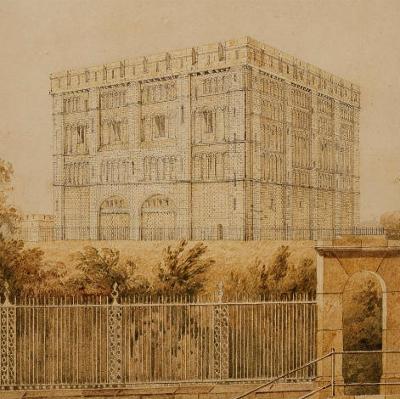History of Norwich Castle

Read a more detailed, illustrated history of Norwich Castle.
From around 1067 the Normans demolished at least 98 Saxon homes in Norwich to make way for the castle earthworks within which they built a wooden fort, surrounded by deep defensive dry ditches.
Once the land had settled, work was begun on the stone keep in 1094 by King William (Rufus) II. Following his death in 1100 it was continued by his brother King Henry I and completed by 1121.
A royal palace
Norwich Castle was designed to be a royal palace rather than a fortification. However, no Norman kings ever lived in it. The only time Henry I is known to have stayed at Norwich Castle was for Christmas 1121, a visit explored in detail in the displays in the Castle Keep.
Norwich Castle keep was built using limestone shipped from Caen in France at a cost of over three times the original value of the stone!
Originally the ground floor walls were faced in flint, in stark contrast to the white limestone of the Royal Palace on the upper level. The upper floor (where the balcony now stands) was divided into two sections. On the north side was the Great Hall, and on the south were the royal quarters which comprised of a large parlour, bedrooms and a private chapel. Within the outer walls is a walkway (fighting gallery) where soldiers could patrol the building.
The Castle's Norman origins are explored in more detail on our Norman Connections website, which sets the Castle in an international architectural context.
The county gaol
From the 14th century the keep was used as a county gaol, until a new gaol, designed by Sir John Soane, was constructed both inside and around the keep in 1792-93.
The prison was quickly seen as outdated and difficult to patrol and so the outside block was demolished between 1822 and 1827.
Local architect William Wilkins won the competition (and £100) to design the new prison. Wilkins had a keen interest in archaeology and it's thanks to his efforts that many original features such as the Norman pillar bases in the keep remain to this day.
Between 1834 and 1839, Norwich Castle's dilapidated exterior was refaced in Bath stone by Architect, John Salvin. His work faithfully replicates the elaborate blank arcading that made Norwich Castle one of the most elaborately decorated of all Norman keeps.
Becoming a museum
In 1883 the county gaol moved to Mousehold Heath in Norwich and work began on converting the building into a museum. Edward Boardman was commissioned to convert the keep and prison. His work involved ripping out Soane's prison cell block and removing rubble from the lower two metres of the keep. To support the new roof, Boardman built two fine open arches down the centre of the keep and installed a balcony at the level of the original Norman floor.
In 1894 Norwich Castle opened as a museum. It displayed the collections of the earlier Norfolk and Norwich Museum, which had occupied various sites in the city since 1825, alongside collections from benefactors.




